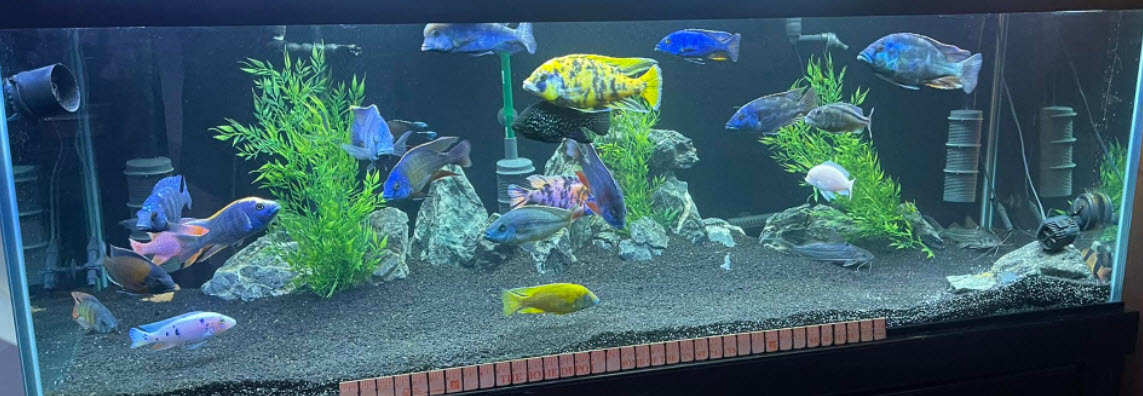
One problem many get into is how to reasonably make a fish-in cycle work to add a decent number of fish in three to six weeks. If one does fish-in cycling properly, you only lightly feed a small number of fish. So how does one get up to a decent number of fish in less than four to six months? Several commentators on this website have asked this very question. So I’ve come up with “milk jug sponge filter cycling”.
The basic idea is to do rapid cycling of a sponge filter outside the aquarium in a milk jug (note some sponge filters are too tall for a one gallon container and need to be done in a two gallon jug, a five gallon pail or a plastic waste basket). Then, when the sponge filter is cycled, add it to the main aquarium AS A SECOND FILTER. One can then take the main aquarium up to a decent number of decent-sized fish after a week or two. Then, four to six months down the road, when the main filter is “mature” one can remove the sponge filter from the aquarium.
Procedure
For this procedure, obtain a decent-sized sponge filter with a large pore-sized sponge, something like one of these filters.
.
.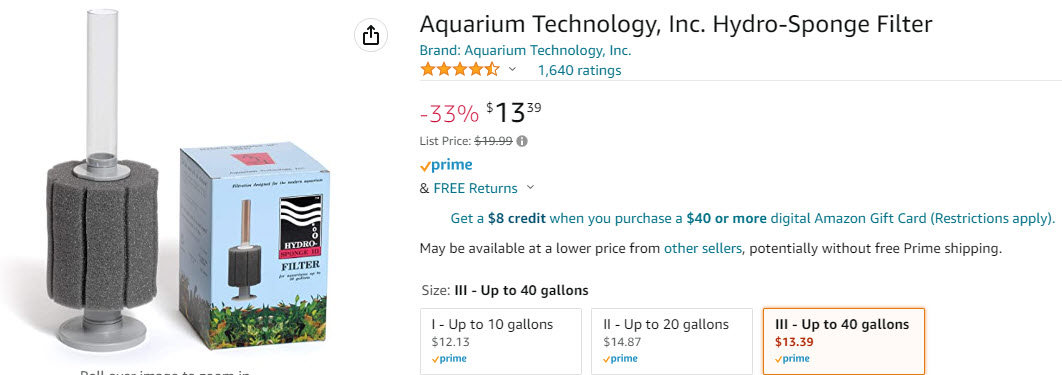
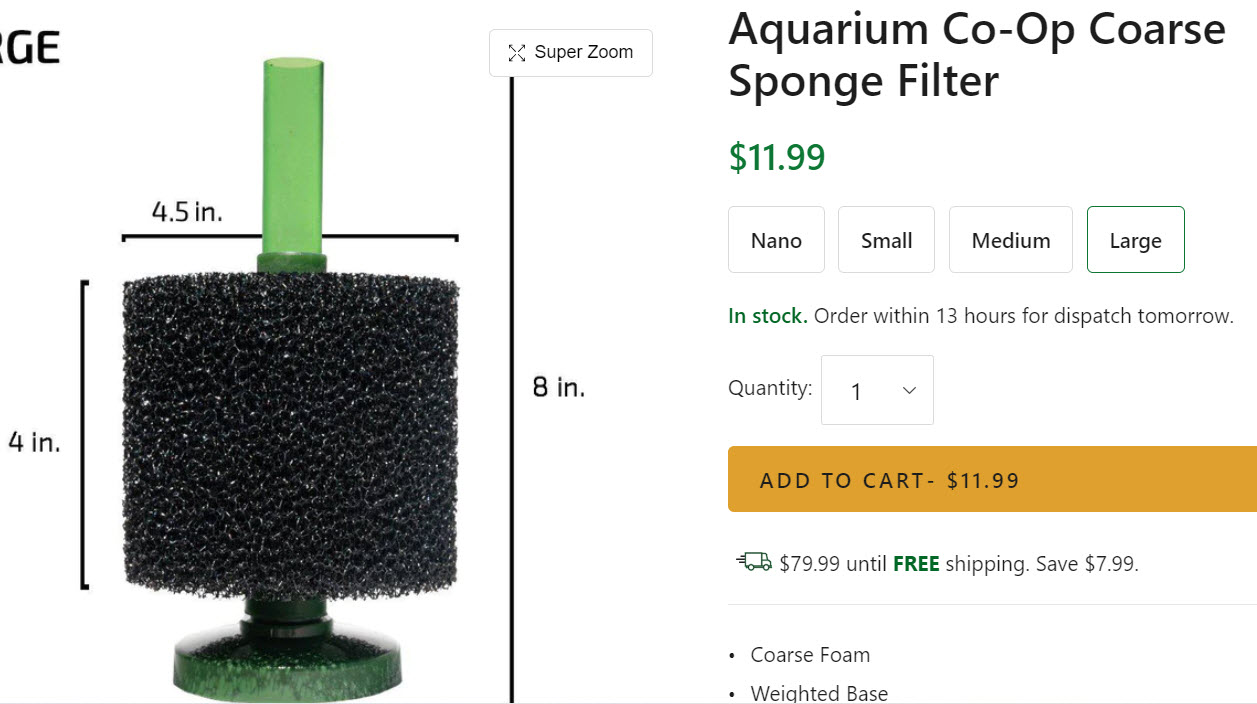
.
Note that it is desirable to have an airstone creating the bubbles. But some sponge filters have a spoked arrangement in their core which requires some cutting in order to get an air stone down there. If that isn’t done they produce large bubbles which “clump and glug”. These bubbles are very noisy and do not lift the water very well.
Obtain a decent-sized air pump, something like this model:
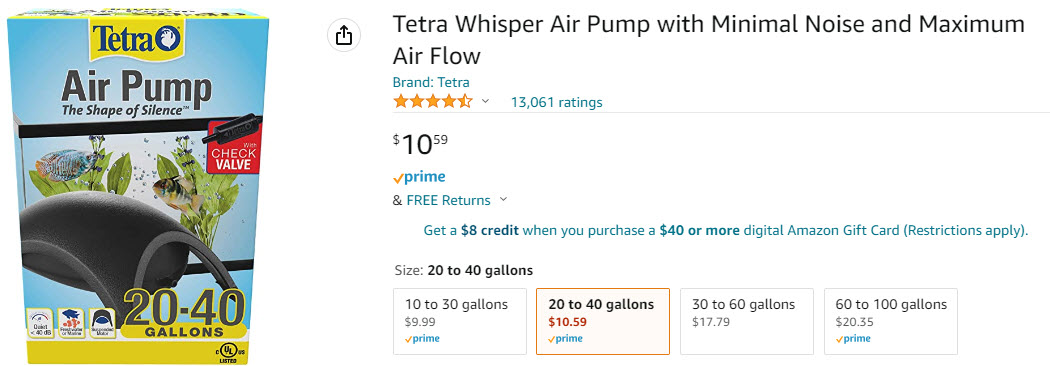
Steps to the process:
- Take a gallon jug and cut off the top, making a small one-gallon container.
- Add the sponge filter and the air pump with an air stone to the jug.
- Put in a heater and heat it to 85 to 90 degrees
- Fill the jug and turn everything on.
- Add one half teaspoon of inoculate: inoculate from existing filter (brown “mulm” in water is great!), black soil from a potted plant, pond mud, compost, etc.
- Add a barley grain sized smidgen of garden fertilizer, one time add only.
- Add ten drops of ammonia, a barley grain sized smidgen of ammonia salt, or a teaspoon of human urine to the jug every day for one week. Then make this addition every three days for a maximum of four weeks.
- The pH for cycling should be 7.4 to 7.8 and MUST be above 6.5. So, add sodium bicarbonate to keep the pH up. The cycling can consume a lot of sodium bicarbonate.
- Do not change the water.
- It will take two to five weeks and the water in the jug should clear.
- You can stop the additions when the ammonia hits less than 0.5 and nitrite hits zero OR at four weeks, whichever is shorter.
- DO NOT SQUEEZE THE SPONGE.
Then put the sponge into your main aquarium. Note this process can also be done in a five gallon bucket. Just multiply all the additions by five. One can also obviously do more than one sponge filter in a five gallon bucket for a larger aquarium. Keep the set-up of the sponge filter the same in the new aquarium. If the filter was running on airstones in the jug, do not switch to a powerhead in the aquarium. Better to just put the powerhead on in the jug.
Do NOT add sugar or fish food to this cycling process. The carbohydrates in these additions give a very soft brown gunk that gets destroyed by even the smallest movement of the sponge filter. Ammonia gives a much more adherent film of beneficial bacteria.
Note that is is normal for such a filter to cause a small ammonia spike when added to the main aquarium. The spike will only last a day or two and will not harm the fish unless the pH is over 8.4.
An Example
One reader cycled one sponge filter in four weeks and one sponge filter in twelve days. The amount of ammonia processed by these filters was sizable. So either one could be added to a fish-in cycled aquarium and make that aquarium a mature aquarium capable of handling a heavy fish load.
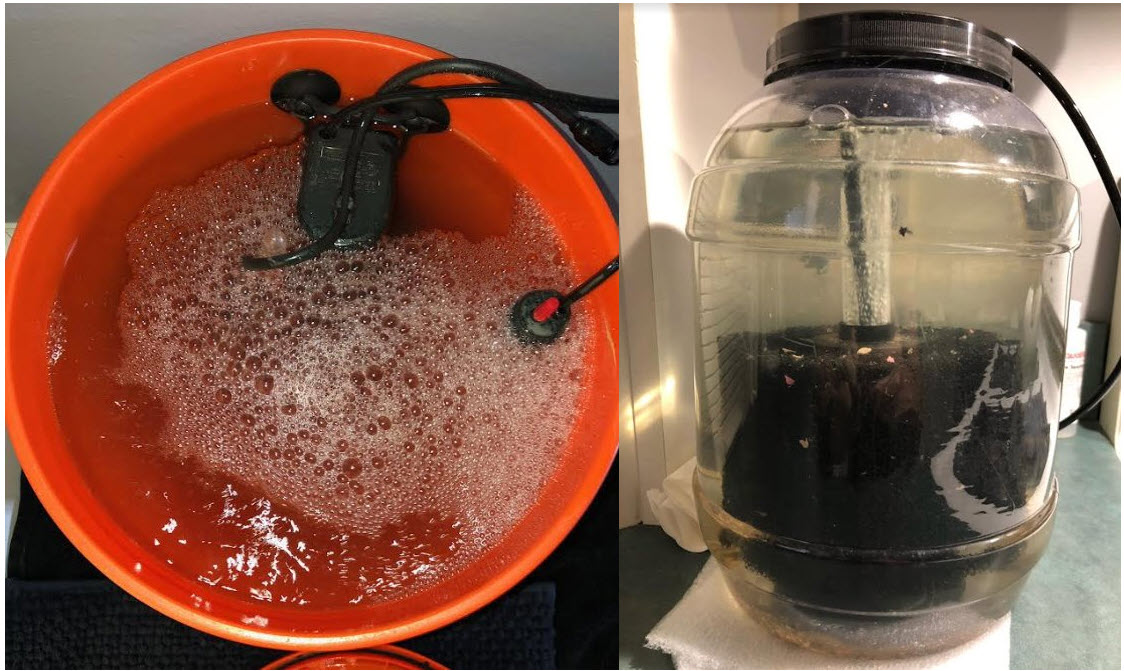
The bucket on the left had a powerhead operated large sponge filter in it. The two gallon jug on the right was a smaller air lift operated sponge filter. The two gallon cycled to a very heavy load in five weeks with manure compost as the starter. The five gallon was then started up with mulmy brown water from the two gallon sponge filter. The five gallon bucket cycled in 12 days.
The “secret ingredient” here in the five gallon bucket is undoubtedly the brown mulm water from the two gallon test. I also suspect the manure was sterilized as my testing showed much faster cycling with manure compost.
.
Return to Cycling Menu
.
Aquarium Science Website
The chapters showed below or on the right side in maroon lead to close to 400 articles on all aspects of keeping a freshwater aquarium. These articles have NO links to profit-making sites and are thus unbiased in their recommendations, unlike all the for-profit sites you will find with Google. Bookmark and browse!
.
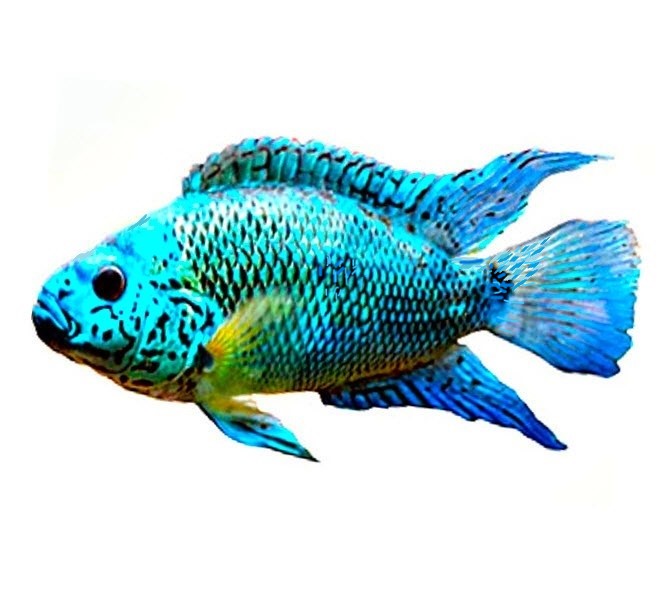
Dave says
In reply to Ken …… You are correct
Ken says
Thank you for this information about cycling in a container.
Is it correct to assume that, for a 5 gallon bucket, 5 teaspoons of human urine would be added daily for the first week and then every 3 days for another 3 weeks?
A Series of Unfortunate Events says
Dave,
Thanks for the response! In the end that’s exactly what I did, hard to believe it took all that typing to figure that simple thing out…
Since I had all those good sponge squeezings sitting around and the Rams were safe, I figured I might as well hop on the ‘bucket cycle’ train. Stuck a small sponge and a heater into a bucket with a ton of brown mulm (‘too much of a good thing’ again, anyone?). I’m dosing it with urine regularly and randomly testing ammonia as I think about. Also randomly stirring it as I think about it, so far so good! Looking forward to trying out your methods for propagating aquatic plants soon as well.
Side note, swapping to Mizuri gel food has been great, all the fish go mad over it. I was worried my adult Severum might hog it all, but the small bits she pushes out of her gill plates as she eats feeds the smaller fish, so much so that they all instantly go to work clearing the water as soon as she munches on a bit. She’s shown 0 aggression over the food, yet they all avoid the larger pieces in favor of the small ‘seconds’ floating about the water column (this has not been the case for other foods).
Dave says
In reply to Luchan …… I would simply transfer the rams to the larger tank for two months while the toxins introduced by the leaf litter dissipate in the smaller tank. In the absence of clearer symptoms I would NOT medicate the food. Leaf litter in small quantities is a good thing, in large quantities it is a bad thing.
A Series of Unfortunate Events says
Evening Dave,
First off I would like to thank you for making this absolute invaluable wealth of knowledge available for everyone. I’m finally understand much much more about the actual science and ‘reasons why’s in this hobby. Thank you.
Secondly, I write for advice, and I apologize in advance for the light novel ahead. You have been warned. Background: I have a 75 gallon tank running on a canister filled wall to wall with foam with zero gaps. The canister, an oase thermo master (overpriced but I love the bells and whistles, sue me), has a built in removable prefilter that I clean specifically when flow slows down, the small ‘filter intake sponge’ sized round sponges are squeezed out into a tub of tank water. I don’t ever even need to think about the foam inside the main canister, and haven’t in 4 years. This tank was inoculated about a month ago with lake mud (convenient, living on a lake).
The problem child. I also have a 20 gallon aquarium with limited plants, mostly floating guppy grass and a few ‘easy’ stem plants. This tank has been established for three years, but about two months ago I made the switch from the rattly annoying retrofitted HOB I’d been using to one of Aquarium Co-Ops sponges (with the tube output at the water line). I added the sponge to the tank alongside the regular filter for a few weeks, then removed the old filter and simply tossed the sponges that were in it inside the tank for another few weeks.
On my journey to better understand the hobby and learn why fishkeeping seemed like it got so much more complicated in the past few years, I stumbled on father fish. Instead of setting up a ‘brand new’ father fish style tank, I was under the impression a conversion would be possible. This has likely happened to many of your readers. I inoculated both of my tanks on September 23, but I admittedly got far too overzealous with the 20 gallon. Too much leaf litter. I had the beginnings of trouble. That led me here.
The real kicker. The fish in the 20 gallon are a (previously) breeding pair of German Blue Rams. The past two weeks their behavior has been ‘off’ and their weekly spawning has halted. Their tank mates are one nerite snail, 7 monk eye tetra, ~8 wild caught grass shrimp, one wild caught snail. As per the API kit ammonia and nitrite read zero. I don’t water change for nitrate. I need to do more research to identify the snail’s species, but it is currently burrowed in the substrate and in two weeks I have not seen it seek air.
Important to note: the snail and shrimps were added at the same time that I added (FAR TOO MUCH) organic inoculate. The shrimps are doing fine, but the snail never moved, aside from occasionally slightly opening it’s operculum. I could see it leaving a little pile of snail poops. A behavioral change in one of the rams alerted me to something being wrong. I realized I’d not only inoculated my tank, but also added a ton of ‘food’ for the new organisms as well. My water never became cloudy, but my male German Blue Rams began ‘flashing’ on objects and occasionally erratically darting off as if to ‘escape’ something. This is not a constant thing, a few acute ’bouts of irritation’ per day. His eating and interest in the female ram are normal. Both of their tail fins are ever so slightly ‘clamped,’ only the tail fins, and more of a ‘dried out paintbrush’ sort of ‘neutral’ position, they are not permanently clamped. Once I noticed this I removed as much of the added material as I could. Interestingly, the wild snail moved for the first time the next night, burrowing shallowly in the substrate. The female ram also began flashing, but even more rarely than the male. I observed it for the first time while writing this novel. The tank is directly next to my desk, I’m at my desk all day and pay close attention to the tank. The moment this pair of rams entered my life they became my all time favorite fish, they were everything I had ever wanted, and somehow I’d never heard of them.
At the time of ‘the incident,’ I assumed I had done enough to the new sponge filter to ‘cycle it,’ not knowing until now about the real maturation process. September 23 I added the materials, one week later the female clamped her tail. The male was chasing her a bit after they both ate their clutch of eggs and I assumed aggression based stress from him wanting to spawn again, or from the lost eggs. One more week passed and the male started exhibiting his bouts of irritation, and I knew immediately something was very very wrong. There is no visible damage to either fish and their colors are still vibrant and beautiful, aside from some darker stress bars on the female. I purchased them from a home hobby breeder and not a farm, Daku Aquatics. At this time I had no idea the actual mechanics surrounding blackwater fish. Boy did I mess up.
Every few days I am sucking any decaying plant matter or ‘loose’ detritus off the bottom, and ensuring my water is crystal clear. The water column itself is extremely clear, I hesitate to say crystal due to my series of unfortunate uneducated mistakes. I have an RODI filter for my house for our drinking water. Our water is around 8.2 ph. Say I remove a gallon of water sucking up material, I will add a gallon of rodi. If I do more than 3 gallons of change, I refill with tap water and treat the tank liberally with prime (I will soon be switching to homemade treatments, thank you for that!). I generally don’t water change often, maybe once a month or two, but my series of unfortunate events has has me changing more than usual.
I strongly believe I nuked the tank with bacteria, and the floor of the tank had become, much like a McDonald’s ball pit, a hotbed of harmful bacteria. I BELIEVE my rams are suffering from this overload of bacteria, and their natural equilibrium with small amounts of things like gill flukes are out of whack, causing them to be more susceptible to illness.
I BELIEVE the current level of diverse bacteria in my filter can’t quite handle the load I put on it yet. I understand just changing water will do nothing. Bio filtration must be increased. My sponge is porous and large, but young.
I have considered the shotgun method to medicate the tank. As soon as it comes in I will be swapping their food from Omega one cichlid flake to mizuri gel food, 50% protein 15% fat. Instead of making my own gelatin based food to supply the medication, would adding it to the formulated gel food be acceptable? My thoughts are yes, but I’m not sure I trust my own thoughts right now, look where they got me.
I don’t believe medicating the tank is going to solve the root problem. I’ve got a small sponge filter lying around, and just yesterday I squeezed out the prefilter sponges on the big tank canister to get the flow moving again. I kept the squeezed out water and mulm in a gallon pickle jar to observe out of curiosity.
My current thought process is use your milk jug cycle method, and just stick the spare sponge filter straight into the gallon pickle jar. There’s about an inch and a half of brown mulm separated out at the bottom. I’ve also considered DIYing something to retrofit some of my canisters prefilter sponges onto one of my existing sponge filters. Another option is moving the rams to my 75. I have a large ~8 inch red shoulder severum, four adult Siamese algae eaters, two three inch clown loaches(I know), and two Bolivian Rams.
Any advice would be appreciated. I understand this is a lot of anecdotal information presented all at once. Thank you for teaching me so much about this hobby.
Dave says
In reply to Philip …… You might try changing out the micro for 30 ppi foam. OR you can add undergravel filters. ALL my fluidized beds used mechanical filtration in the form of under-gravel filters, a point I missed when writing up the section on fluidized beds. My bad.
Phillip Callus says
Hello,
I have an 1000 litre tank which is 9 months old with 30 african cichlids in it and a 200 litre sump using the fluidized K1 media.
The sump is divided into 3 chambers. 1st with K1+, 2nd K1 micro and 3rd for pump and heater.
After reading your site, looks like I didn’t cycle my tank and filter properly to start with.
My water is always cloudy lately, last month or so.
Evolutions Aqua site says to fill media to 30% loading.
I have added more media to the chambers to give me 60% loading as your recommendation about a week ago.
Should I leave it all tumbling together, new with old media in the sump chambers?
Or, I was thinking after reading your site, of removing some media from the sump, each chamber at a time, placing the K1+ in a bucket with a heater and air stone and trying a rapid cycle, as you have explained with the foam filter method?
Then placing the media back to the sump after cycling.
Once completed, trying chamber 2 with my K1 micro and following the same steps.
Your thoughts will be appreciated.
Thanks.
Dave says
In reply to Newbie fish ….. white water with a 15% water change just shouldn’t be. I’ve never heard anything like what you have going on. It just shouldn’t happen. Just a thought, buy some new dechlorinator that says “sodium thiosulfate” and try that. Dechlorinators can go bad with time.
NewbFish says
Could really use your help solving a mystery.
A recent 15% water change in a 4 month old moderately planted 20 gal tank with 10 neocaridina shrimp, 1 endler female, 10 endler fry and 3 amano shrimp, seems to have caused a cycle crash, effectively making mine a fish-in cycle. Water got really white, cloudy and fish began hiding then gasping at the water surface, even with addition of hob and airstone-driven filter (existing filters: minipump-driven nylon scrubbies filter and airstone-driven sponge filter with nylon pot scrubbers added). I moved most of what I could catch to quarantine.
The issue isn’t limited to this tank. I think something has changed in my tap water. I discovered water changes in other tanks also cause a cycle crash. Two tanks that have not had water change are fine.
I think the tap water might have changed in a way that even an excessive amount of dechlorinator is no longer working. I even got a different type of test strip, but am seeing the same results: no reduction in chlorine. In the pool test strip it shows 0 ppm free chlorine, 2-3 ppm total chlorine. In the Aquarium Co-op test strip, it is between 0 and 0.8 ppm chlorine (I don’t know if that is total or free). The only other noticeable change is that the PH has gone down each time dechlorinator is added).
Help! Can you suggest things to test or try? I am afraid to perform any more water changes, if my source water is not treatable for chlorine, or it causes cycle crashes each time.
Anonymous says
Wanted to report back that I did rapid cycling of 4 sponge filters in a 10L tank and with some dirt and old filter squeezings as inoculate and the ammonium hydrogen carbonate for ammonia and it’s taken 11 days (possibly less, I didn’t bother testing ammonia/nitrite/nitrate until today) for them to cycle the ammonia and nitrites to nitrate. The dirt has put some tannins in the water so it’s hard to tell whether the water is at crystal clear yet, but it looks pretty sparkling apart from the amber tint, so I’m going to move the filters into their destinations.
Thanks for sharing all your hard work!